Search for W' boson production in the top quark decay channel
| As particle physicists, we have formed a picture of the particles and forces that comprise our world for several decades. This picture is well developed and understood by now, and the model that we use to describe it has been widely successful in explaining observed phenomena and correctly predicting new measurements. We call it the standard model, and the particles and force carriers are shown in the graphic on the right. | 
|
When looking for more evidence of this new physics, we try to be as general as possible and look in all possible directions. Also, we as experimentalists sometimes prefer searches that don't depend too much on any specific theoretical model and instead focus on rather general features that can be found in many different theories. One such general feature is the existence of new forces that are simply too weak to have been observed yet. Such a new force might manifest itself as a new force carrier that is similar to one of the existing particles, but much heavier. The new force carriers are labeled by the standard model particle they mirror, with the addition of an apostrophe (') to signal that they are a copy, except that they have a larger mass. One such new force carrier is a copy of the W boson of the standard model, called the W' boson.
| At high energy particle colliders
these W' boson particles may be produced, but only rarely. Furthermore, when they do get produced, they are expected
to be too short-lived
to be observed directly. Instead, we may only observe their decay products. And sometimes even the decay products themselves are too short-lived to be observed, in which case we can only observe their decay products. And sometimes even their decay products are too short-lived ... well, you get the picture. We are in particular interested in the connection between the W' boson and the top quark because it is far heavier than any of the other particles and may thus plays a special role and provide a door to possible new physics. |

|
The search for production of a single top quark is one of the most exciting analyses currently being done at the Tevatron, and the search for a W' boson builds upon the work done there. This search is simpler though because the W' bosons we are looking for are so heavy that they would stick out of the dataset like a sore thumb.
When we look through our dataset, we only find a handful of events, and they look just like what we expect from background processes predicted by the standard model. These are for example the production of top quark pairs via the strong force, a process that looks just like the W' boson process if some of the decay products of those top quarks are not detected properly in our detector.
Thus we have performed a sensitive search but have not observed a W' boson signal. Not observing anything means that we can set limits on the production rate of these W' bosons. And we know from our friends in theoretical physics that a light W' boson would have a rather large production rate and we should have seen it if it existed. We thus conclude that a light W' boson doesn't exist and that, if it exists at all, the W' boson must be very heavy (if it decays to a top-bottom quark pair of course).
The story does not end here. The DØ detector has accumulated over five times more data already. We are also improving our understanding of the detector and other aspects of this analysis and we expect to be sensitive to possible W' bosons with even higher masses in the near future.
The full article can be found here. For more information on this analysis, please contact the primary authors: Reinhard Schwienhorst, Lev Dudko, Maxim Perfilov.
Last updated on August 29, 2006.